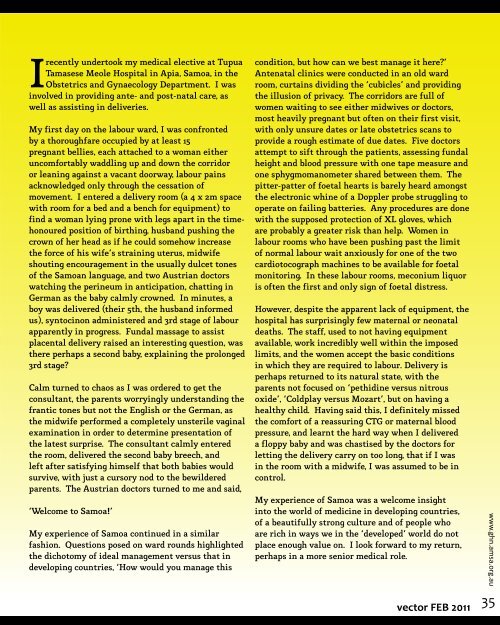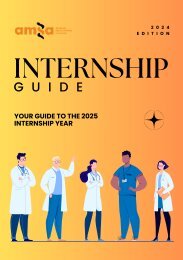Create successful ePaper yourself
Turn your PDF publications into a flip-book with our unique Google optimized e-Paper software.
I<br />
recently undertook my medical elective at Tupua<br />
Tamasese Meole Hospital in Apia, Samoa, in the<br />
Obstetrics and Gynaecology Department. I was<br />
involved in providing ante- and post-natal care, as<br />
well as assisting in deliveries.<br />
My first day on the labour ward, I was confronted<br />
by a thoroughfare occupied by at least 15<br />
pregnant bellies, each attached to a woman either<br />
uncomfortably waddling up and down the corridor<br />
or leaning against a vacant doorway, labour pains<br />
acknowledged only through the cessation of<br />
movement. I entered a delivery room (a 4 x 2m space<br />
with room for a bed and a bench for equipment) to<br />
find a woman lying prone with legs apart in the timehonoured<br />
position of birthing, husband pushing the<br />
crown of her head as if he could somehow increase<br />
the force of his wife’s straining uterus, midwife<br />
shouting encouragement in the usually dulcet tones<br />
of the Samoan language, and two Austrian doctors<br />
watching the perineum in anticipation, chatting in<br />
German as the baby calmly crowned. In minutes, a<br />
boy was delivered (their 5th, the husband informed<br />
us), syntocinon administered and 3rd stage of labour<br />
apparently in progress. Fundal massage to assist<br />
placental delivery raised an interesting question, was<br />
there perhaps a second baby, explaining the prolonged<br />
3rd stage?<br />
Calm turned to chaos as I was ordered to get the<br />
consultant, the parents worryingly understanding the<br />
frantic tones but not the English or the German, as<br />
the midwife performed a completely unsterile vaginal<br />
examination in order to determine presentation of<br />
the latest surprise. The consultant calmly entered<br />
the room, delivered the second baby breech, and<br />
left after satisfying himself that both babies would<br />
survive, with just a cursory nod to the bewildered<br />
parents. The Austrian doctors turned to me and said,<br />
‘Welcome to Samoa!’<br />
My experience of Samoa continued in a similar<br />
fashion. Questions posed on ward rounds highlighted<br />
the dichotomy of ideal management versus that in<br />
developing countries, ‘How would you manage this<br />
condition, but how can we best manage it here?’<br />
Antenatal clinics were conducted in an old ward<br />
room, curtains dividing the ‘cubicles’ and providing<br />
the illusion of privacy. The corridors are full of<br />
women waiting to see either midwives or doctors,<br />
most heavily pregnant but often on their first visit,<br />
with only unsure dates or late obstetrics scans to<br />
provide a rough estimate of due dates. Five doctors<br />
attempt to sift through the patients, assessing fundal<br />
height and blood pressure with one tape measure and<br />
one sphygmomanometer shared between them. The<br />
pitter-patter of foetal hearts is barely heard amongst<br />
the electronic whine of a Doppler probe struggling to<br />
operate on failing batteries. Any procedures are done<br />
with the supposed protection of XL gloves, which<br />
are probably a greater risk than help. Women in<br />
labour rooms who have been pushing past the limit<br />
of normal labour wait anxiously for one of the two<br />
cardiotocograph machines to be available for foetal<br />
monitoring. In these labour rooms, meconium liquor<br />
is often the first and only sign of foetal distress.<br />
However, despite the apparent lack of equipment, the<br />
hospital has surprisingly few maternal or neonatal<br />
deaths. The staff, used to not having equipment<br />
available, work incredibly well within the imposed<br />
limits, and the women accept the basic conditions<br />
in which they are required to labour. Delivery is<br />
perhaps returned to its natural state, with the<br />
parents not focused on ‘pethidine versus nitrous<br />
oxide’, ‘Coldplay versus Mozart’, but on having a<br />
healthy child. Having said this, I definitely missed<br />
the comfort of a reassuring CTG or maternal blood<br />
pressure, and learnt the hard way when I delivered<br />
a floppy baby and was chastised by the doctors for<br />
letting the delivery carry on too long, that if I was<br />
in the room with a midwife, I was assumed to be in<br />
control.<br />
My experience of Samoa was a welcome insight<br />
into the world of medicine in developing countries,<br />
of a beautifully strong culture and of people who<br />
are rich in ways we in the ‘developed’ world do not<br />
place enough value on. I look forward to my return,<br />
perhaps in a more senior medical role.<br />
www.ghn.amsa.org.au<br />
vector FEB <strong>2011</strong><br />
35

















